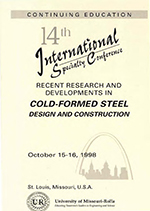Session Dates
15 Oct 1998
Abstract
This paper is the second paper by the authors on the subject of the behavior of cold formed steel hat sections in bending with multiple intermediate longitudinal stiffeners. The first paper, also contained in these Proceedings, deals with the test results only (Acharya and Schuster, 1998). Presented in this paper is the analysis associated with the test program that was conducted at the University of Waterloo. The main objective was to develop a consistently accurate and practical method of predicting the ultimate bending strength of sections that fail in overall plate buckling. Recent testing carried out by previous researchers indicates that the bending resistance of multiple stiffened cold formed steel members which fail in overall plate buckling is too conservatively predicted by the current Canadian design standard (S136-94). These researchers have also shown that the American design specification (A1S1 96) is also unconservative for the same sections. This investigation primarily includes a theoretical study that is substantiated with the experimental data summarized in the first paper. The current North American design methods were evaluated with respect to their ability to predict the strength of the test specimens. Based on the work by Lind (Lind, 1973), which is shown to adequately predict the strength of sections that experience overall plate buckling, an alternate design method for strength determination is presented.
Department(s)
Civil, Architectural and Environmental Engineering
Research Center/Lab(s)
Wei-Wen Yu Center for Cold-Formed Steel Structures
Meeting Name
14th International Specialty Conference on Cold-Formed Steel Structures
Publisher
University of Missouri--Rolla
Document Version
Final Version
Rights
© 1998 University of Missouri--Rolla, All rights reserved.
Document Type
Article - Conference proceedings
File Type
text
Language
English
Recommended Citation
Acharya, V. V. and Schuster, R. M., "Analysis of Hat Sections with Multiple Intermediate Longitudinal Stiffeners" (1998). CCFSS Proceedings of International Specialty Conference on Cold-Formed Steel Structures (1971 - 2018). 2.
https://scholarsmine.mst.edu/isccss/14iccfsss/14iccfsss-session2/2
Analysis of Hat Sections with Multiple Intermediate Longitudinal Stiffeners
This paper is the second paper by the authors on the subject of the behavior of cold formed steel hat sections in bending with multiple intermediate longitudinal stiffeners. The first paper, also contained in these Proceedings, deals with the test results only (Acharya and Schuster, 1998). Presented in this paper is the analysis associated with the test program that was conducted at the University of Waterloo. The main objective was to develop a consistently accurate and practical method of predicting the ultimate bending strength of sections that fail in overall plate buckling. Recent testing carried out by previous researchers indicates that the bending resistance of multiple stiffened cold formed steel members which fail in overall plate buckling is too conservatively predicted by the current Canadian design standard (S136-94). These researchers have also shown that the American design specification (A1S1 96) is also unconservative for the same sections. This investigation primarily includes a theoretical study that is substantiated with the experimental data summarized in the first paper. The current North American design methods were evaluated with respect to their ability to predict the strength of the test specimens. Based on the work by Lind (Lind, 1973), which is shown to adequately predict the strength of sections that experience overall plate buckling, an alternate design method for strength determination is presented.



